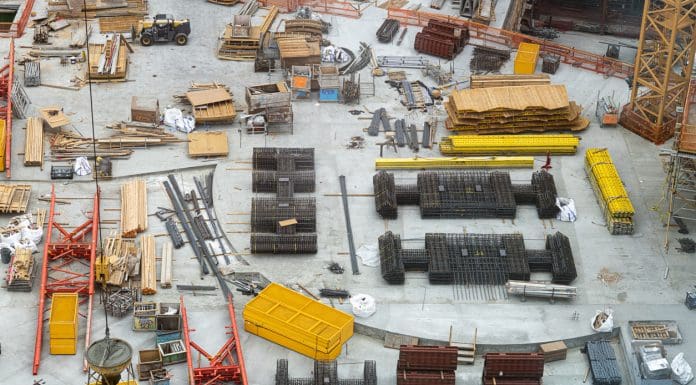
How protectionism, tariffs, and geopolitical volatility are reshaping procurement, pricing, and project delivery in the UK construction sector, according to a new report
The construction industry is facing a mounting storm of geopolitical and economic pressures as a resurgent wave of protectionism — spearheaded by the re-elected Trump administration — reshapes global trade patterns and supply chain security.
With tariffs returning as a frontline trade policy, material price inflation, supply disruptions, and operational uncertainty are now critical risks for construction leaders navigating the delicate balance between commercial performance and geopolitical volatility.
Tariffs and protectionism redefine the construction supply chain
In April 2025, the Trump administration imposed a 10% baseline tariff on multiple trade partners, with higher targeted tariffs on critical construction materials such as steel, aluminium, timber, and copper. This strategy, framed under the “America First Trade Policy,” has sent shockwaves through global supply chains.
Data from the Associated Builders and Contractors revealed a 9.7% annualised rise in input costs for US construction firms in the first quarter of 2025. The implications for global markets — particularly the UK and Europe — are profound, with ripple effects felt in material pricing, project schedules, and procurement strategies.
Steel and aluminium: The double-edged sword of global trade
Steel and aluminium — the backbone of modern construction — are particularly exposed. Despite China’s dominance in global steel production, Canada is the largest supplier of steel and aluminium to the US, accounting for 24% of steel and 41% of aluminium imports.
New 25% tariffs on Canadian steel have already driven up US market prices, increasing costs for downstream buyers and squeezing margins. While China remains a price-setter in global markets, its direct impact on US supply is minor, comprising just 1.6% of US steel imports.
In Europe, the picture is mixed. Germany and Italy face pressure from reduced EU-to-US exports, while UK contractors may benefit in the short term from redirected Chinese surpluses — though this could expose them to future volatility.
Timber tariffs fuel cross-atlantic price hikes
Timber, long regarded as a staple material and now a key player in low-carbon construction, has been caught in the crossfire. 70% of US timber imports come from Canada, with tariffs nearing 35%, pushing North American prices to multi-year highs.
For the UK, where 19% of timber imports originate from the US, these increases translate into higher procurement costs. Scandinavian suppliers are absorbing some demand, but supply chain bottlenecks and redirected trade flows from Canada have added new pressures to a market already coping with sustainability-driven material demands.
Copper: The strategic commodity under siege
The global demand for copper — driven by the electric vehicle boom, renewable energy, and infrastructure upgrades — is colliding with tightening supply and intensifying trade tensions. In early 2025, copper prices in the US surged by 29%, fueled by tariffs, persistent demand, and heightened market uncertainty.
With 45% of US copper imports sourced from Chile and Canada, and China maintaining a dominant position as a consumer and strategic stockpiler, any escalation in trade disputes could severely impact global supply. Europe and the UK, reliant on Chile and Peru for copper, are bracing for continued price volatility and constrained supply, particularly as mining output struggles to keep pace with demand.
UK construction caught between sustainability goals and global risk
For UK construction leaders, the challenges are compounded by stringent sustainability targets. The UK Net Zero Carbon Buildings Standard (introduced in 2024) — though voluntary — is reshaping material choices, driving demand for sustainable alternatives like low-carbon concrete and responsibly sourced timber.
Yet, despite strong domestic cement production (covering 97% of UK demand), reliance on imported materials like aluminium and timber — and the surge in global copper prices — is heightening cost pressures. The industry is further constrained by a persistent skilled labour shortage, exacerbated by post-Brexit immigration policies and an ageing workforce.
Supply chain resilience: Reshoring, nearshoring, and strategic partnerships
Construction firms are responding by rethinking their supply chains. Reshoring, nearshoring, and supplier diversification have emerged as key strategies to build resilience. While this can mitigate some risks, it introduces higher operational costs and complexity — particularly when relocating away from entrenched global suppliers like China.
These shifts are not confined to Western economies. Countries like South Korea and Vietnam are imposing tariffs on Chinese steel, signalling a broader regional move toward supply chain independence and domestic industry protection.
Integrating geopolitical risk into strategic leadership
Experts now urge construction leaders to embed geopolitical risk into their Enterprise Risk Management (ERM) frameworks. This includes:
- Scenario-based risk assessments
- Continuous geopolitical monitoring
- Strategic partnerships with insurers and advisory firms
Such integrated approaches allow companies to anticipate trade shocks, mitigate financial risk, and maintain project continuity in a turbulent global landscape.
Conclusion: Navigating the perfect storm
The convergence of trade wars, material cost inflation, sustainability pressures, and labour shortages presents a complex — and potentially volatile — operating environment for UK construction firms.
The industry’s ability to adapt supply chains, embrace strategic risk management, and engage proactively with insurers and advisors will be critical to safeguarding project delivery and financial resilience in the face of global uncertainty.
The post Global trade tensions push construction supply chains to breaking point appeared first on Planning, Building & Construction Today.

